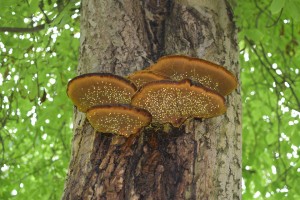One of the most obvious afflictions that affects trees is fungus. We see various types of tree fungus likely every day. Some types of tree fungus don’t harm the tree and actual provide benefits, while other types of fungus can damage the tree and lead to diseases and death.
Knowing the different types of fungus can help you understand when your trees are at risk.
Types of Tree Fungus
There are three main types of fungus that affect trees:
- Symbiotic / Mycorrhizal fungi
- Saprophytic fungi
- Parasitic fungi
Symbiotic / Mycorrhizal fungi
This type of fungus lives in association with many plants’ and trees’ root systems. Both the fungi and the tree benefit from the exchange. The fungi has access to the trees’ carbohydrate stores, and the tree grows its ability to absorb water and minerals because of the highly absorbent mycelium. Symbiotic fungi basically expands the root system of the tree on which it lives, allowing both the tree and fungus to grow stronger.
Common types of this fungus are Fly Agaric (Amanita muscaria) and Porcelain fungus (Oudemansiella mucida).
Saprophytic fungi
Saprophytic fungi are commonly seen on dead or dying plants and trees, although they are not often the cause of the death or decline themselves. It lives on dead organic matter and takes advantage of dieback caused by a separate factor, like drought or disease. Their role in the forest ecosystem is important, like symbiotic fungi, but they are not positive to see on trees. Seeing saprophytic fungi on trees often means the tree is already sick, dying, or dead and can contribute further to their mechanical failure.
Common types of saprophytic fungi are King Alfred’s Cakes (Daldinia concentrica) and Many-zoned Polypore (Coriolus versicolor).
Parasitic fungi
Parasitic fungi, as their name suggests, are the most damaging to trees and plants. They live off of their host tree and directly result in the death of the tree or plant. Usually, these fungi target trees that are already stressed or unhealthy, and can worsen conditions to kill the trees. In times of spreading infestations and infections, parasitic fungi can be particularly damaging to trees.
Dutch elm disease in the 1970s was caused by a parasitic fungus, microscopic Ophiostoma novo-ulmi. Honey fungus is another common parasitic fungus.
Common Diseases Caused by Fungus
When a fungus begins to live on a tree, it can make it susceptible to more diseases as it begins to weaken the mechanical structure of the tree. A spore can germinate under certain environmental conditions that produce hyphae (fungal tissue) that enter and feed on the host.
Some common examples of this are:
- Root and butt rot disease – These diseases infect and kill the roots of the tree, causing decay and resulting in total tree failure with very little notice or visible symptoms
- Canker diseases – These diseases enter through wounds on the tree and infect the bark tissue
- Foliar / shoot diseases – These are the most common diseases caused by fungus. You can see blotches on leaves and needles that can lead to the death of the leaf and in some cases, the death of the tree
- Vascular wilts – When wilts invade the tree’s vascular system, it interrupts the transport of water and nutrients
Management Options for Fungus on Trees
Unfortunately, fungus cannot usually be cured once it is living on a tree. There are not many tree fungus treatments available. Prevention is the best method for keeping your trees healthy without any negative effects from certain types of fungus.
Planting your trees in the right place, keeping them watered and fertilized in times of drought, and keeping them healthy can help prevent fungus from finding an opportunity to live on your tree. Correct pruning methods can help eliminate certain canker diseases and reduce the risk of open wounds on your trees. Fungicides do exist to control certain diseases caused by fungus and inhibit the growth of fungi, but these must be applied preventatively – before an infection occurs.
There are dozens of types of tree fungi that affect trees in Southern Ontario. An arborist can diagnose the types of fungus on a tree and let you know how it will affect the tree in the long term. Because there are so many types of fungi, there are many management options for the trees on your property.
If you suspect your tree is infected with a fungus, contact P & A. We can give a diagnosis and help create a management plan for preventing the spread of the fungus and keeping your trees healthy.
